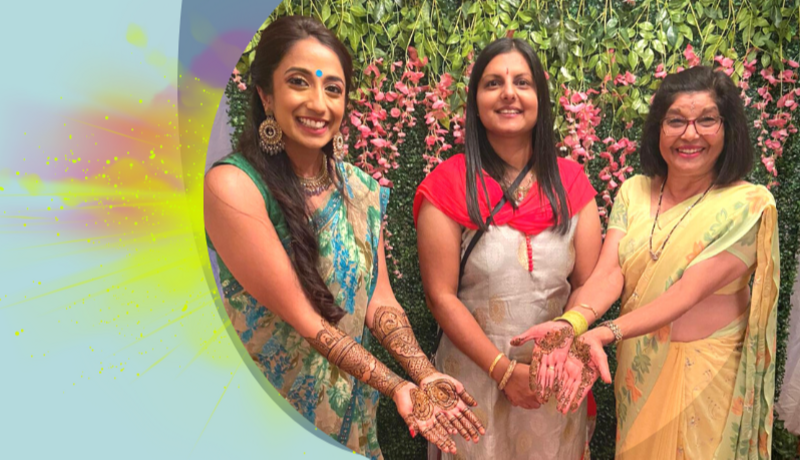Celebrating Holi with Veran Lad
Posted on March 2023

Wishing a Happy Holi to everyone celebrating.
We spoke to Veran Lad from our Credit Control team about how she celebrates Holi and the significance it holds for her.
Holi takes place according to the Lunar calendar, so it’s never on the exact same date each year, but it’s always at the time when Winter ends and Spring begins. Everything in Hindu culture has symbolism behind it, nothing is done just for the sake of doing it; moving on from the hard, cold Winter represents good triumphing over evil, even though it’s not actually that cold in India! The celebrations are about forgetting all the bad parts of the previous year and focusing on becoming a better person for the year ahead.
To celebrate, everyone in the community will gather at the Mandir – the Hindu Temple –in the evening. Starting at the Mandir, we light a Diya – a candle made of ghee and wool –and begin a procession that swoops around towards a big bonfire which represents cleansing and the burning away of all the bad things from the past year. Quite a few of my family are part of our community in Coventry, so when I’m in the procession line for the bonfire I love getting to see my uncles, aunties, cousins and family friends.
Once we reach the bonfire, we throw in coconuts, flowers, incense sticks, and other items as a Puja, which is a blessing. Some food becomes your Prasada which is blessed by God and you get to take home and share with your family. For example, half of the coconut you throw into the fire and the other half you enjoy later with popcorn and dates and fruit. When we were younger, they didn’t have barricades or fire crews on standby as they do now, so people would take their life into their hands, shove a coconut into the fire and run off!
After the bonfire, we’ll go home and have dinner at my mum’s house, because she’s a really good cook. Mum will do traditional vegetarian foods like samosas and pakoras and vegetable curries followed by Rasgulla and Gulab Jamun for desserts, they’re Indian stuffed sweets and are exceptionally high in calories, it’s just like eating sugar but it’s the best thing ever!
When I was younger, I was lucky enough to visit India when it was Holi and Divali, and it’s a very different experience over there. Holi is a two-day festival and a national holiday in the majority of India, so everyone is off work and celebrating. The first night is the bonfire celebration with fireworks and music, and the following day is the Rangoli event with lots of coloured powder! All the colours represent something, for example, red represents marriage, green represents life, and everyone throws around the powder and water balloons, celebrating with music and food and dancing; it’s like a rave without the drinks!It doesn't work as well in England, because it’s always cold when it’s celebrated in February or March, so having someone throw a water balloon in your face isn’t quite as fun...
All the Holi celebrations are family-orientated, which is typical of any Hindu festival. For example, on New Year’s Day, after we go to the Temple and do blessings, we go to people’s houses in the community and try to see as many people as we can, even if it’s just a flying visit. There’s a saying on New Year’s that what you do on that day will carry on for the rest of the year, so that’s the significance of seeing family and friends. Holi has the same perspective, it’s about letting go of all your worries and troubles and starting fresh.
Recent Articles
-
Will Pardoe | Improving Offer Acceptance: The Importance of the Interview Experience
Having a strong shortlist of well-qualified candidates is only part of the hiring process; there ...
12 days ago -
Case Study: Supporting Trustees of The London Clinic with Critical Interim EBME Engineers
When The London Clinic faced the sudden departure of three in-house EBME Engineers, their leader...
18 days ago -
Nik Stoate | How to stand out in a tough market
What you can control when hiring local government lawyersIn today's challenging and competitive ...
27 days ago